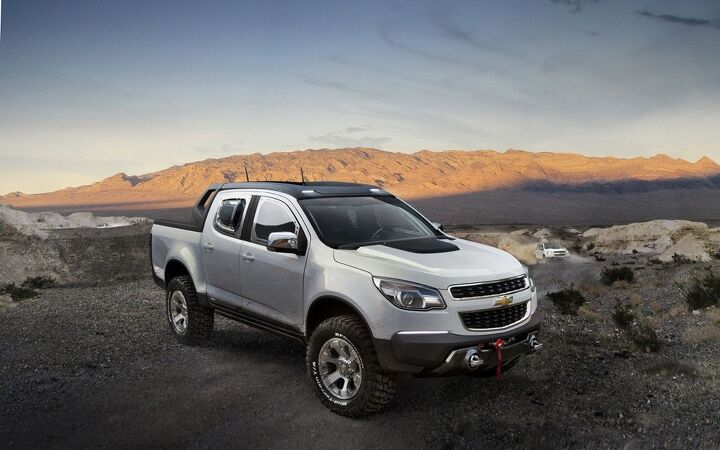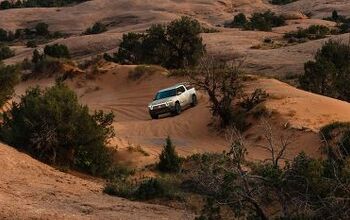GM Plans Ford Raptor-Fighter With Upcoming Colorado

When the next generation Chevrolet Colorado was announced last fall, it was heralded as the start of a new era in mid-size trucks in the US. Aside from the diesel engine and manual gearbox we were promised, the Colorado might also get a Ford SVT Raptor-rivaling off-road variant.
SVT thoroughly redesigned the F150’s suspension to make a capable “pre-runner” style truck. Up front, new control arms and revised geometry gave an impressive 11.2″ of travel, controlled by a triple-bypass FOX Racing shock. In rear, revised leaf springs, a reinforced rear axle housing, and more FOX Racing shocks allowed for just over 12″ of travel. The entire suspension package also widened the track width by seven inches, for increased roll stability, and raised the suspension about two inches over a standard 4×4 F150. Composite bodywork wrapped the widened suspension up nicely, and changes were made to the F150’s stability control to allow for more curious use of the new capabilities, though when toying with one at a friendly local rallycross track down here in San Marcos, Texas, we found that the stability systems would still nag during modest maneuvers. But the package was downright impressive, where SVT made the package work was in the suspension tuning, especially with the triple-bypass FOX Racing shocks, something typically reserved for desert prerunner and race trucks.
A bypass shock has a series of “bypass valves” along the shock piston’s travel, which bypass shock oil around the piston and through a valve that controls the rate of flow, with each bypass allowing for a different rate of flow. This allows different amounts of damping at different points of a shock’s travel, where as a standard shock has the same damping over its entire length of travel, by allowing fluid to bypass the shock piston and flow through the different bypass valves at set locations along the piston’s travel. More information and detailed photos of an external bypass shock can be seen here.
This gives the Raptor its secret sauce: soft dampening at lesser lengths of travel allow for the suspension to quickly absorb small bumps at speed — gravel, ruts and other minor deformations — while still being able to slow the compression travel of the shock as the truck lands larger hits and jumps, preventing the suspension from bottoming out. Perhaps the only weakness of the SVT Raptor was its size, and more noticeably, its weight.
This is where the upcoming Colorado can make a difference. While offroad packages are no stranger to compact trucks, with Toyota’s TRD package standing out in the Tacoma, most really only equip you for mild jeep-trails. The emphasis on travel and suspension dampening are unique to the Raptor. But where the F150’s size and weight are ultimately weaknesses, the Colorado’s compact size and relatively low weight would make the platform a great choice for the Prerunner suspension design used in the Raptor. Less weight translates into better handling, better braking, lower center of gravity, and less of the suspension travel being used to absorb the energy of the vehicles body weight as it inevitably attempts to land a 75 mile per hour jump at a motocross track.
GM also refreshed the trademarks on the ZR2 moniker, not long ago. S10 fanatics will remember the ZR2 as a healthy offroad package for the second generation S10, including 1″ wider track, 3″ taller ride height, upgraded front differential and rear axle, and a few other additions. It would make sense that the ZR2 moniker could return with the Colorado and Canyon should this Raptor-fighter appear.

More by Phillip Thomas
Latest Car Reviews
Read moreLatest Product Reviews
Read moreRecent Comments
- Calrson Fan Jeff - Agree with what you said. I think currently an EV pick-up could work in a commercial/fleet application. As someone on this site stated, w/current tech. battery vehicles just do not scale well. EBFlex - No one wanted to hate the Cyber Truck more than me but I can't ignore all the new technology and innovative thinking that went into it. There is a lot I like about it. GM, Ford & Ram should incorporate some it's design cues into their ICE trucks.
- Michael S6 Very confusing if the move is permanent or temporary.
- Jrhurren Worked in Detroit 18 years, live 20 minutes away. Ren Cen is a gem, but a very terrible design inside. I’m surprised GM stuck it out as long as they did there.
- Carson D I thought that this was going to be a comparison of BFGoodrich's different truck tires.
- Tassos Jong-iL North Korea is saving pokemon cards and amibos to buy GM in 10 years, we hope.



































Comments
Join the conversation
I think it looks like some kind of space rover.
If GM follows Ford's technique of longer A arms to increase wheel travel this truck will be as wide as a stock full sized truck. I'd be okay with that since the Raptor would be too wide for most trails I go on.